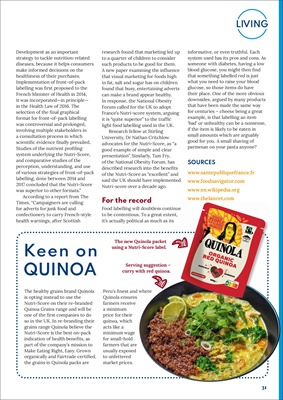
31
LIVING
Development as an important
strategy to tackle nutrition-related
diseases, because it helps consumers
make informed decisions on the
healthiness of their purchases.
Implementation of front-of-pack
labelling was first proposed to the
French Minister of Health in 2014,
it was incorporated-in principle-
in the Health Law of 2016. The
selection of the final graphical
format for front-of-pack labelling
was controversial and prolonged,
involving multiple stakeholders in
a consultation process in which
scientific evidence finally prevailed.
Studies of the nutrient profiling
system underlying the Nutri-Score,
and comparative studies of the
perception, understanding, and use
of various strategies of front-of-pack
labelling, done between 2014 and
2017 concluded that the Nutri-Score
was superior to other formats."
According to a report from The
Times, "Campaigners are calling
for adverts for junk food and
confectionery to carry French-style
health warnings, after Scottish
research found that marketing led up
to a quarter of children to consider
such products to be good for them.
A new paper examining the influence
that visual marketing for foods high
in fat, salt and sugar has on children
found that busy, entertaining adverts
can make a brand appear healthy.
In response, the National Obesity
Forum called for the UK to adopt
France's Nutri-score system, arguing
it is "quite superior" to the traffic
light food labelling used in the UK.
Research fellow at Stirling
University, Dr Nathan Critchlow
advocates for the Nutri-Score, as "a
good example of simple and clear
presentation". Similarly, Tam Fry,
of the National Obesity Forum, has
described research into the benefits
of the Nutri-Score as "excellent" and
said the UK should have implemented
Nutri-score over a decade ago.
For the record
Food labelling will doubtless continue
to be contentious. To a great extent,
it's actually political as much as its
informative, or even truthful. Each
system used has its pros and cons. As
someone with diabetes, having a low
blood glucose, you might then find
that something labelled red is just
what you need to raise your blood
glucose, so those items do have
their place. One of the more obvious
downsides, argued by many products
that have been made the same way
for centuries - cheese being a great
example, is that labelling an item
'bad' or unhealthy can be a nonsense,
if the item is likely to be eaten in
small amounts which are arguably
good for you. A small shaving of
parmesan on your pasta anyone?
SOURCES
www.santepubliquefrance.fr
www.foodnavigator.com
www.en.wikipedia.org
www.thelancet.com
The healthy grains brand Quinola
is opting instead to use the
Nutri-Score on their re-branded
Quinoa Grains range and will be
one of the first companies to do
so in the UK. In re-branding their
grains range Quinola believe the
Nutri-Score is the best on-pack
indication of health benefits, as
part of the company's mission to
Make Eating Right, Easy. Grown
organically and Fairtrade certified,
the grains in Quinola packs are
Peru's finest and where
Quinola ensures
farmers receive
a minimum
price for their
quinoa, which
acts like a
minimum wage
for small-hold
farmers that are
usually exposed
to unfettered
market prices.
Serving suggestion -
curry with red quinoa.
The new Quinola packet
using a Nutri-Score label.